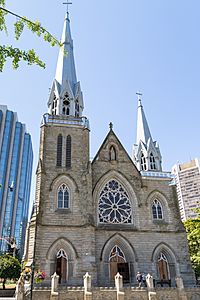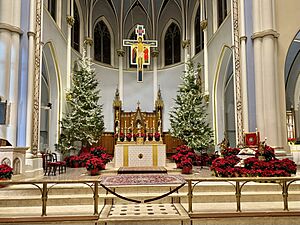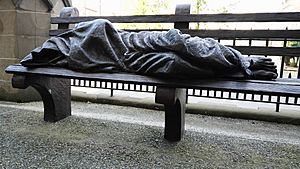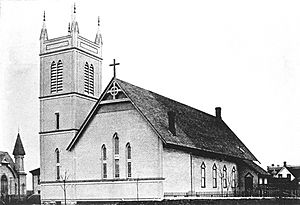Holy Rosary Cathedral (Vancouver) facts for kids
Quick facts for kids Holy Rosary Cathedral |
|
|---|---|
| The Metropolitan Cathedral of Our Lady of the Holy Rosary | |
 |
|
| 49°16′55″N 123°06′53″W / 49.281846°N 123.114606°W | |
| Location | 646 Richards Street, Vancouver |
| Country | Canada |
| Denomination | Roman Catholic |
| History | |
| Status | Cathedral |
| Consecrated | October 3, 1953 |
| Architecture | |
| Functional status | Active |
| Architect(s) | Julian and Williams |
| Style | French Gothic |
| Groundbreaking | July 16, 1899 |
| Completed | December 8, 1900 |
| Specifications | |
| Capacity | 700 |
| Administration | |
| Archdiocese | Roman Catholic Archdiocese of Vancouver |
The Holy Rosary Cathedral is a beautiful and historic church in Vancouver, Canada. It's also known as the Metropolitan Cathedral of Our Lady of the Holy Rosary. This church was built a long time ago, in the late 1800s. It looks like a French Gothic style building, which means it has tall spires and pointed arches, similar to old churches in France.
This special church is the main cathedral for the Roman Catholic Archdiocese of Vancouver. You can find it right in the downtown area of the city, where Richards and Dunsmuir streets meet.
Building the cathedral started in 1899. It was built on the same spot where an older church with the same name used to stand. The new church officially opened on December 8, 1900. It was blessed the very next day. Many years later, in 1953, it was formally consecrated, which is a special blessing ceremony.
People say its style reminds them of the famous Chartres Cathedral in France, which is a very old medieval church. In 1916, this church became a cathedral. It's now listed on the Vancouver Heritage Register, which means it's a protected building because of its history and importance.
Contents
History of the Cathedral
How the Church Began (1887–1899)
The church community started in June 1885. Father Patrick Fay was chosen to be the first leader. He was a chaplain for workers on the Canadian Pacific Railway (CPR). Father Fay held the first church service in 1885. It was on the feast day of Our Lady of the Rosary.
At first, services were held in different halls. But soon, it was clear that a new, permanent church was needed. The community was growing, with 69 families attending.
There's a story about how Father Fay picked the spot for the new church. He supposedly went to the Coal Harbour waterfront. From there, he looked south towards the forest, which is now downtown Vancouver. He chose the spot with the tallest tree!
Construction of the first wooden church began in 1886. It was finished and blessed the next year. Two years later, the church was made bigger. A bell tower was also added.
Building the Grand Cathedral
Vancouver was growing very fast back then. So, plans were made to build an even bigger church. Father Fay was moved to a different area in 1892 and passed away soon after. Father Eumellin took over the building plans from 1893 to 1897.
Then, Father James McGuckin became the new pastor. By this time, the church was too small for all the people. To pay for the new church, Father McGuckin's religious group, the Missionary Oblates of Mary Immaculate (OMI), took out a loan on their main building in France. Father Fay also worked as a foreman for a construction team to help raise money before he passed away.
At first, many people, including the OMI, had doubts about the project. The church already had a lot of debt. The Catholic community in Vancouver was still small, even though it was growing. Also, a friend of Father McGuckin who was a contractor couldn't give the money he had promised. Because of these problems, the building project was even called "McGuckin's Folly," meaning it was thought to be a foolish idea.
Despite the doubts, the first stone of the new church was laid on July 16, 1899. Archbishop Adélard Langevin from Saint Boniface led this ceremony. Thomas Ennor Julian and H.J. Williams were the architects. The church was built very quickly, in just 491 days!
When it was finished, people praised it as "the finest piece of architecture west of Toronto and north of San Francisco." The new Church of Our Lady of the Holy Rosary opened on December 8, 1900. Archbishop Alexander Christie from Portland, Oregon blessed it the next day.
By 1910, this church became the most important church financially in the area. It was the only one that could make enough money to cover its costs and even have extra. Because of this, Archbishop Timothy Casey wanted to make it the main cathedral for the region. The OMI group didn't want to give up their church. They even tried to give Archbishop Casey money to buy land somewhere else to build a new cathedral.
However, the church officially became a cathedral in 1916. The Oblates were allowed to stay there. The OMI, who had managed the church since 1893, finally left in 1927. This was due to problems with the loan that helped build the cathedral. Also, fewer people were joining their order, causing a "manpower shortage."
A Catholic church can only be formally consecrated once it is free from debt. So, the Holy Rosary Cathedral wasn't consecrated until October 3, 1953. This was 53 years after it first opened!
The ceremony started early in the morning. It was led by Archbishop William M. Duke of Vancouver. Bishop Michael Harrington from Kamloops celebrated the special Mass afterward. About 35 bishops from Canada and the United States attended. This event also celebrated Archbishop Duke's 50th year as a priest and 25th year as a bishop.
On October 7, 1952, the feast day of the cathedral's namesake, a person entered the church. They fired a gun at the altar. Luckily, no one was hurt, and the person was arrested quickly. In April 1959, a small tilt was noticed in the bell tower. This was probably caused by nearby tunnel construction.
Important Events at the Cathedral
Many important events have happened at the Holy Rosary Cathedral. In 1936, it hosted a large church gathering called a Eucharistic Congress. This was the first time such an event was held in Western Canada.
Forty-eight years later, in September 1984, Pope John Paul II visited the church. This was part of his trip to Canada. In late September 2001, the cathedral was the first place in Canada to host the relics of Saint Thérèse of Lisieux. Her relics toured the country for three months.
A special memorial service was held on May 2, 2025. It was for victims of a tragic incident in Vancouver. The government of British Columbia declared it a day of remembrance. The Premier, Mayor, and police chief attended and spoke to the people.
Over the years, many important people have had their funeral services at the cathedral. These include beloved lifeguard Joe Fortes (1922). Also, Chief Dan George of the Tsleil-Waututh Nation (1981). And former Vancouver police commissioner William Cameron Murphy (1961). Joe Fortes's funeral in February 1922 filled the cathedral. Thousands more stood outside in the rain to watch the procession.
Funeral services were also held for Popes Pius XI (1939), John Paul II (2005), Benedict XVI (2023), and Francis (2025). A service for former Governor General of Canada Georges Vanier was held in 1967.
Cathedral Architecture and Design

The Holy Rosary Cathedral is built in a French Gothic style. It has a cruciform shape, like a Latin cross, when viewed from above. The outside walls are made from sandstone from Gabriola Island. Its foundations are made of strong granite.
The two bell towers are different sizes. They are called the cathedral's "most prominent visual feature." The taller steeple was planned to have special supports called flying buttresses at the bottom. Inside, the columns that hold up the main part of the church, called the nave, are made from red marble.
The main chair for the bishop, called the cathedra, is in the center of the sanctuary. It is surrounded by a wooden altar-piece and two tall structures called reredos. The church building is about 161 feet long, 104 feet wide, and 62 feet tall. The taller steeple reaches up to 217 feet.
Over the years, the cathedral has been updated many times. In late 1932, the metal scales on the taller steeple were cleaned and fixed. The cross on top was repainted. The sanctuary area was rearranged in the 1960s after the Second Vatican Council.
More updates happened before Pope John Paul II visited in 1984. The cathedral got a completely new roof from 1995 to 1997. Zinc was used to make the roof look like slate. In December 2002, some of the carpet was removed. It was replaced with Italian ceramic tiles. The inside of the church was repainted from 2004 to 2006.
The Cathedral Bells
When the cathedral was first built, seven bells were made in France. They were meant to represent the sacraments. These bells were blessed on October 21, 1900. However, they were found to be out of tune. So, they were sent back to Europe, this time to a factory near Bristol, England.
This time, eight bells were made. They were designed to play a full musical octave when rung. They were put back in the cathedral in 1906. These bells work using a special method called change ringing. They are one of the few sets of bells in North America that ring in the English style. In British Columbia, there are only three such sets. The others are at Westminster Abbey in Mission and Christ Church Cathedral in Victoria.
The bells were famously rung on Dominion Day in 1911. This was the first time a full set of bells was rung in Canada. They were also rung on February 12, 2010. This was to celebrate the opening of the 2010 Winter Olympics in Vancouver.
The Grand Organ

The cathedral's pipe organ was first built in the autumn of 1900. It was made by the Karn–Warren Organ Company in Woodstock, Ontario. This organ is the "oldest romantic-style organ" in British Columbia. It is special because it's still in its original location.
Over the years, the organ started to wear out. It also had some bad repairs and water damage from a leaky roof. So, in 1999, the organ was taken apart. It was sent to a company called Casavant Frères in Saint-Hyacinthe, Quebec.
The organ was fixed within two years. It was brought back to the church and blessed in Easter of 2000. In that same year, the cathedral started hosting organ concerts. These concerts have been held every year since then.
Beautiful Stained Glass Windows
The cathedral has 21 beautiful stained glass windows. The most famous ones were made by a Canadian artist named Guido Nincheri. These five windows show important scenes. They include Our Lady of the Holy Rosary, the Baptism of Jesus, Jesus Healing the Sick, Jesus with the Children, and the Assumption.
The window showing Our Lady of the Holy Rosary was even featured on a Canada Post Christmas stamp in 1997. The Institute for Stained Glass in Canada has also documented all the stained glass windows at the cathedral.
Altar of Relics
To the right of the main altar is a special side altar for relics. This altar was finished in late 2024. It was built to show relics of different saints. People can come to see and honor these relics.
Some of the relics displayed include those of the Twelve Apostles. Also, the Canadian Martyrs like Jean de Brébeuf, Gabriel Lalemant, and Charles Garnier. Other saints include Thomas Aquinas, Thomas More, Thérèse of Lisieux, Pope John Paul II, and Mother Teresa.
Homeless Jesus Sculpture

A copy of the bronze sculpture Homeless Jesus was placed in front of the cathedral in spring 2017. It was created by Canadian artist Timothy Schmalz. The sculpture shows a life-size man lying on a park bench. He wears a long overcoat. His face is hidden under a hood, and his bare feet show marks called stigmata.
Stanley Galvon, who was the rector at the time, said the statue is meant to make people think. It helps them consider the issue of homelessness in the city.
The Cathedral Today
In 2007, the cathedral was in the news. The Vancouver Police Department had to be called often. Church staff said they were having problems with people asking for money. These incidents happened almost daily. This became public when a homeless man robbed an 81-year-old church member inside the cathedral on August 1, 2007. The event was caught on camera.
On March 23, 2008, First Nations protesters gathered outside the cathedral. They were demonstrating during an Easter Sunday Mass. They asked the Church to "get off native land." They also demanded to know where children who died in residential schools were buried.
A similar protest happened on October 30, 2011. A group from the Occupy Vancouver movement marched to the cathedral. They tried to enter and occupy the church. But Vancouver police officers and Knights of Columbus stopped them.
For the first time in its history, Sunday Mass was held without people present on March 22, 2020. This happened because the Archdiocese stopped all public masses starting March 21. This was in response to the 2019–20 coronavirus pandemic. Public masses at the cathedral started again three months later in June. The number of people allowed was reduced to 50 per Mass. This was to follow the physical distancing rules set by health authorities.
See also
 In Spanish: Catedral del Santo Rosario (Vancouver) para niños
In Spanish: Catedral del Santo Rosario (Vancouver) para niños



